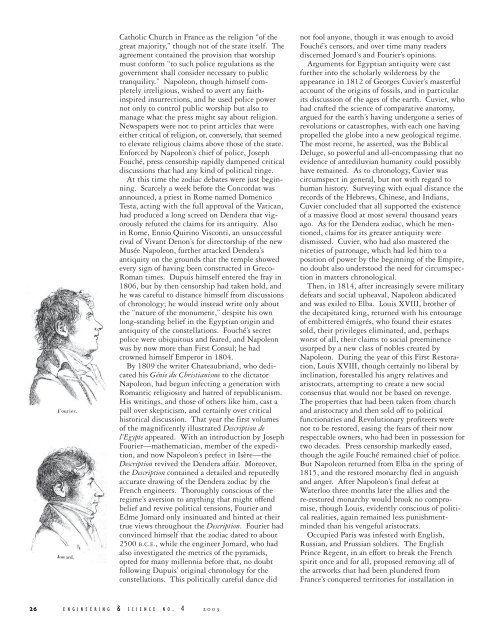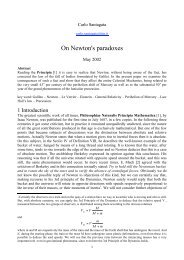Egyptian Stars under Paris Skies - Engineering & Science - Caltech
Egyptian Stars under Paris Skies - Engineering & Science - Caltech
Egyptian Stars under Paris Skies - Engineering & Science - Caltech
Create successful ePaper yourself
Turn your PDF publications into a flip-book with our unique Google optimized e-Paper software.
Catholic Church in France as the religion “of the<br />
great majority,” though not of the state itself. The<br />
agreement contained the provision that worship<br />
must conform “to such police regulations as the<br />
government shall consider necessary to public<br />
tranquility.” Napoleon, though himself completely<br />
irreligious, wished to avert any faithinspired<br />
insurrections, and he used police power<br />
not only to control public worship but also to<br />
manage what the press might say about religion.<br />
Newspapers were not to print articles that were<br />
either critical of religion, or, conversely, that seemed<br />
to elevate religious claims above those of the state.<br />
Enforced by Napoleon’s chief of police, Joseph<br />
Fouché, press censorship rapidly dampened critical<br />
discussions that had any kind of political tinge.<br />
At this time the zodiac debates were just beginning.<br />
Scarcely a week before the Concordat was<br />
announced, a priest in Rome named Domenico<br />
Testa, acting with the full approval of the Vatican,<br />
had produced a long screed on Dendera that vigorously<br />
refuted the claims for its antiquity. Also<br />
in Rome, Ennio Quirino Visconti, an unsuccessful<br />
rival of Vivant Denon’s for directorship of the new<br />
Musée Napoleon, further attacked Dendera’s<br />
antiquity on the grounds that the temple showed<br />
every sign of having been constructed in Greco-<br />
Roman times. Dupuis himself entered the fray in<br />
1806, but by then censorship had taken hold, and<br />
he was careful to distance himself from discussions<br />
of chronology; he would instead write only about<br />
the “nature of the monument,” despite his own<br />
long-standing belief in the <strong>Egyptian</strong> origin and<br />
antiquity of the constellations. Fouché’s secret<br />
police were ubiquitous and feared, and Napoleon<br />
was by now more than First Consul; he had<br />
crowned himself Emperor in 1804.<br />
By 1809 the writer Chateaubriand, who dedicated<br />
his Génie du Christianisme to the dictator<br />
Napoleon, had begun infecting a generation with<br />
Romantic religiosity and hatred of republicanism.<br />
His writings, and those of others like him, cast a<br />
pall over skepticism, and certainly over critical<br />
historical discussion. That year the first volumes<br />
of the magnificently illustrated Description de<br />
l’Egypte appeared. With an introduction by Joseph<br />
Fourier—mathematician, member of the expedition,<br />
and now Napoleon’s prefect in Isère—the<br />
Description revived the Dendera affair. Moreover,<br />
the Description contained a detailed and reputedly<br />
accurate drawing of the Dendera zodiac by the<br />
French engineers. Thoroughly conscious of the<br />
regime’s aversion to anything that might offend<br />
belief and revive political tensions, Fourier and<br />
Edme Jomard only insinuated and hinted at their<br />
true views throughout the Description. Fourier had<br />
convinced himself that the zodiac dated to about<br />
2500 B.C.E., while the engineer Jomard, who had<br />
also investigated the metrics of the pyramids,<br />
opted for many millennia before that, no doubt<br />
following Dupuis’ original chronology for the<br />
constellations. This politically careful dance did<br />
not fool anyone, though it was enough to avoid<br />
Fouché’s censors, and over time many readers<br />
discerned Jomard’s and Fourier’s opinions.<br />
Arguments for <strong>Egyptian</strong> antiquity were cast<br />
further into the scholarly wilderness by the<br />
appearance in 1812 of Georges Cuvier’s masterful<br />
account of the origins of fossils, and in particular<br />
its discussion of the ages of the earth. Cuvier, who<br />
had crafted the science of comparative anatomy,<br />
argued for the earth’s having <strong>under</strong>gone a series of<br />
revolutions or catastrophes, with each one having<br />
propelled the globe into a new geological regime.<br />
The most recent, he asserted, was the Biblical<br />
Deluge, so powerful and all-encompassing that no<br />
evidence of antediluvian humanity could possibly<br />
have remained. As to chronology, Cuvier was<br />
circumspect in general, but not with regard to<br />
human history. Surveying with equal distance the<br />
records of the Hebrews, Chinese, and Indians,<br />
Cuvier concluded that all supported the existence<br />
of a massive flood at most several thousand years<br />
ago. As for the Dendera zodiac, which he mentioned,<br />
claims for its greater antiquity were<br />
dismissed. Cuvier, who had also mastered the<br />
niceties of patronage, which had led him to a<br />
position of power by the beginning of the Empire,<br />
no doubt also <strong>under</strong>stood the need for circumspection<br />
in matters chronological.<br />
Then, in 1814, after increasingly severe military<br />
defeats and social upheaval, Napoleon abdicated<br />
and was exiled to Elba. Louis XVIII, brother of<br />
the decapitated king, returned with his entourage<br />
of embittered émigrés, who found their estates<br />
sold, their privileges eliminated, and, perhaps<br />
worst of all, their claims to social preeminence<br />
usurped by a new class of nobles created by<br />
Napoleon. During the year of this First Restoration,<br />
Louis XVIII, though certainly no liberal by<br />
inclination, forestalled his angry relatives and<br />
aristocrats, attempting to create a new social<br />
consensus that would not be based on revenge.<br />
The properties that had been taken from church<br />
and aristocracy and then sold off to political<br />
functionaries and Revolutionary profiteers were<br />
not to be restored, easing the fears of their now<br />
respectable owners, who had been in possession for<br />
two decades. Press censorship markedly eased,<br />
though the agile Fouché remained chief of police.<br />
But Napoleon returned from Elba in the spring of<br />
1815, and the restored monarchy fled in anguish<br />
and anger. After Napoleon’s final defeat at<br />
Waterloo three months later the allies and the<br />
re-restored monarchy would brook no compromise,<br />
though Louis, evidently conscious of political<br />
realities, again remained less punishmentminded<br />
than his vengeful aristocrats.<br />
Occupied <strong>Paris</strong> was infested with English,<br />
Russian, and Prussian soldiers. The English<br />
Prince Regent, in an effort to break the French<br />
spirit once and for all, proposed removing all of<br />
the artworks that had been pl<strong>under</strong>ed from<br />
France’s conquered territories for installation in<br />
26 ENGINEERING & SCIENCE NO. 4 2003




